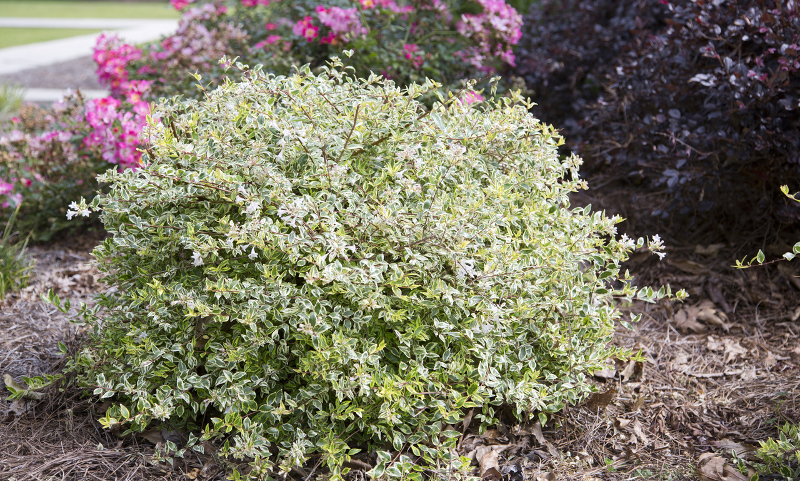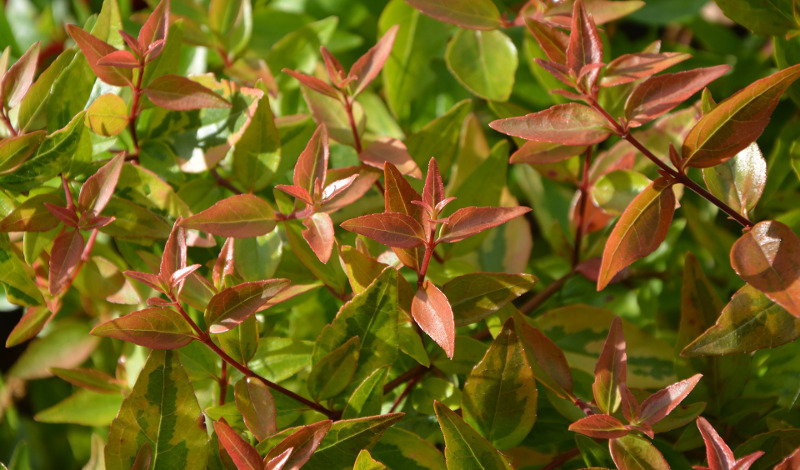Abelias are beautiful, low-maintenance, and underused garden workhorses with a stellar bloom time, multihued changing foliage, and easy-going adaptable natures. You can see the resemblance to their honeysuckle cousins in their tubular, often fragrant flowers so attractive to hummingbirds, butterflies, and other pollinators in summer through fall.
The family includes 30 species of deciduous and evergreen shrubs native to Mexico and Eastern Asia and ranging from two to 10 feet tall. Glossy abelia (A. x grandiflora) is the most commonly seen in the garden and can be evergreen or semi-evergreen depending on the climate. The group is hardy from zones 4 – 11, depending on the variety.

Planting Abelias
Abelias like a site from full sun to partial shade with even moisture in fertile, well-drained soil. The best planting times are spring or fall. Create a hole twice as wide and as deep as the root ball. Keep the crown slightly above the soil level.
Watering Abelias
The best growth and flowering results from even watering. Once established, some drought and heat can be tolerated. Water particularly well during the first two years, perhaps one to two inches a week. After two years, watering twice a week should suffice unless the weather is especially hot and dry.

Fertilizing Abelias
Abelias benefit from a slow-release fertilizer in early spring. Look for a type made for woody plants rather than annuals. Amend soil as needed with dressing of compost and organic amendments in fall.
Pruning Abelias
Abelias only need minimal pruning for shaping. They have naturally lush dense growth. Cut out any errant straight water shoots that appear. To rejuvenate an older abelia, thin out by removing 1/3 of the oldest/tallest branches from the base every few years. The ideal time for pruning is in spring. This ensures healthy growth patterns and reduces pruning stress on the shrubs.

Caring For Abelias in Pots
Choose a dwarf variety that will get no more than three feet tall, and an appropriate-sized pot with drainage. Place in a sunny or partially shaded location. Plant with high-quality potting mix high in organic matter, and lightly fertilize with slow-release fertilizer and repeat annually in spring. Prune mature shrubs as needed in spring by removing 1/3 of the oldest growth to the base.
Winter Care for Abelias
Amend soil with compost and organic matter in fall. If your area is subject to strong freezes, add a winter mulch to keep the roots moist. No need to cut back in the winter. If your plant is long overgrown, you can prune in spring by cutting back about a third of the tallest branches to the ground for three years in a row. In spring, add a slow-release fertilizer.
Common Abelia Care Questions
Do Abelias Lose Their Leaves In The Winter?
Abelias are semi-evergreen bushes, however in warmer climates, they're evergreen. In some cooler climates, zones 6 or even 7, during particularly cold, rough winters, they may lose some of all of their leaves, and they may die back to the ground for the winter in zones 5 and 6, so the answer to your question is, it depends on your climate.
How Cold Hardy Are Abelias?
Abelias are tough and most varieties can tolerate temperatures down to zero degrees fahrenheit, and some varieties may tolerate lower or only warmer temperatures.
What Is The Growth Rate For Abelias?
There are a lot of variables that will affect the growth rate of any plant but generally speaking, Abelias have a moderate to fast growth rate, and they can gain anywhere from 1 to 2 feet a year!
Have a question about Abelias? Fill out the form below and we will try and get back to your question as soon as possible. We may even feature your question on this article to help other gardeners!
 |
Author Erica Browne Grivas - Published 06-16-2021 |
